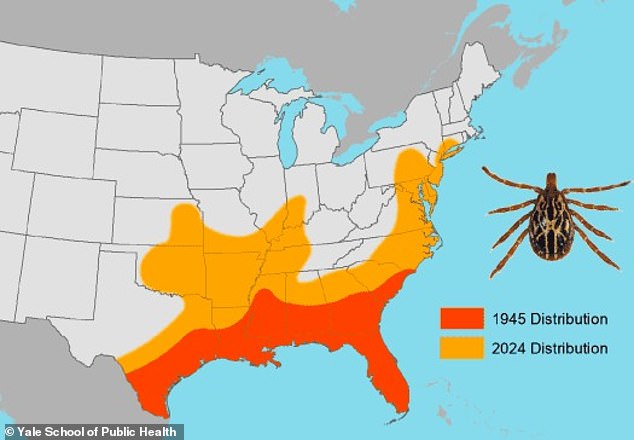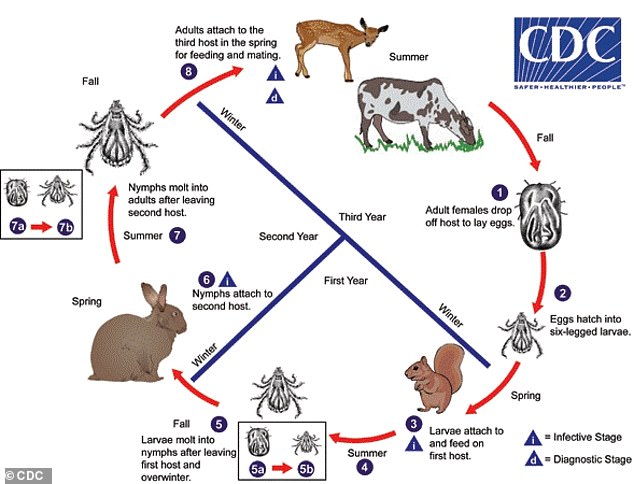First case of rare parasite-borne disease reported in the Northeast – as scientists warn, more states could be next
The first case of a rare parasite-borne disease has been reported in the Northeast after a woman in Connecticut was bitten by an invasive tick.
Scientists at Yale University reported that the 29-year-old woman was infected with Rickettsia parkeri rickettsiosis after a Gulf Coast tick attached itself to her neck.
R. parkeri rickettsiosis, a bacteria, causes a dark scab at the bite site, fever, headache, rash and muscle pain, and can be life-threatening if not treated in time.
While the woman has since recovered, experts are urging people in the Northeast to be on the lookout for the invasive parasites spreading disease to new areas.
The Gulf Coast tick is the only known carrier of R. parkeri bacteria in the US. These disease-spreading parasites are moving north and have infected a woman in Connecticut
Dr. Goudarz Molaei, associate professor at the Yale School of Public Health, said: ‘Rising global temperatures, ecological changes, reforestation and increases in trade and travel are important underlying factors influencing the speed and extent of the expansion of the distribution area of ticks and associated pathogens.
‘It is expected that global warming due to climate change may lead to the continued expansion of the range and abundance of several tick species, increasing their importance as emerging threats to humans, domesticated animals and wildlife.’
Gulf Coast ticks are typically found around the Gulf Coast region, which includes coastal areas along the Atlantic Coast and Gulf of Mexico from Texas to Florida.
But these blood-sucking parasites have moved further north in recent decades, spreading to the mid-Atlantic states and establishing populations from Delaware to Maryland.
Additional populations of this tick species with higher infections have also been reported in New York and New Jersey.
Recent population assessments have suggested they are now creeping into New England and making landfall in Rhode Island and Connecticut.
The Gulf Coast tick is the only known carrier of R. parkeri bacteria in the US.
They are easily distinguished by the graceful markings on their red bodies.
Adult males have clean, white lines in a web-like formation all over the body and adult females have bright, white markings on the dorsal shield.
When they bite people or animals, they can cause diseases called spotted fever rickettsioses or spotted fever.
These diseases are usually not life-threatening and can be treated with antibiotics. But in extreme cases, they can lead to fatal complications such as organ damage, especially if not treated quickly.
Fortunately for the 29-year-old woman infected in Connecticut, the tick that bit her was sent to a state facility that tests ticks for diseases.
Tests showed the tick was carrying R. parkeri, and a blood test showed the woman was infected. She was given a course of antibiotics and recovered quickly.

As their name suggests, Gulf Coast ticks are most commonly found in the Gulf Coast. But in recent decades they have expanded their range north and are now present as far as New England

The life cycle of the Gulf Coast tick. This species is a three-host tick, meaning it feeds on three different hosts during its life cycle
Although this case was quickly resolved, it is yet more evidence that tick-borne diseases are an increasing threat to public health in the US.
Tick populations expand into new areas for a number of reasons.
As climate change increases average temperatures around the world, colder areas in the US are getting warmer. This increases the time ticks can remain active throughout the year, and allows them to thrive in places where they previously could not.
“For the native tick species we have, such as black-legged ticks, climate change is causing those tick species to move further north,” Molaei said. Gizmodo.
But when it comes to invasive species, like the Gulf Coast tick, it’s also about providing a favorable environment for them once they land in a new spot, Molaei said.
Gulf Cost ticks’ preferred habitat is grassland, so one factor that could fuel their expansion northeast is the restoration and conservation of grassland in states like Connecticut in New York, he explained.
Spotted Fevers aren’t the only emerging tick-borne diseases spreading in the US.
Babesiosis, anaplasmosis, Powassan virus and Eastern equine encephalitis are just a few of the diseases that have infected more than average people in recent years.
“There is a need for physicians and patients in our state and across the Northeastern U.S. to recognize that we are dealing with several invasive tick species, and that each of these tick species carries their own diseases,” Molaei said.
